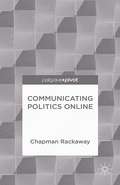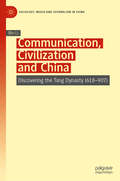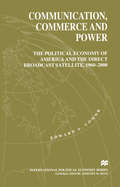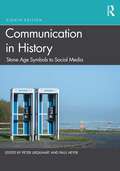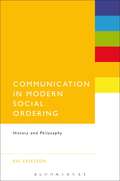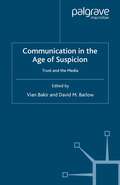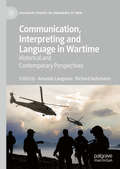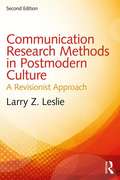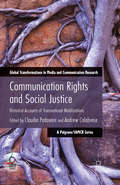- Table View
- List View
Communicating International Development (Rethinking Development Series (PDF))
by Florencia Enghel Jessica Noske-TurnerInternational development stakeholders harness communication with two broad purposes: to do good, via communication for development and media assistance, and to communicate do-gooding, via public relations and information. This book unpacks various ways in which different efforts to do good are combined with attempts to look good, be it in the eyes of donor constituencies at large, or among more specific audiences, such as journalists or intra-agency decision-makers. Development communication studies have tended to focus primarily on interventions aimed at doing good among recipients, at the expense of examining the extent to which promotion and reputation management are elements of those practices. This book establishes the importance of interrogating the tensions generated by overlapping uses of communication to do good and to look good within international development cooperation. The book is a critical text for students and scholars in the areas of development communication and international development and will also appeal to practitioners working in international aid who are directly affected by the challenges of communicating for and about development.
Communicating International Development (Rethinking Development Ser.)
by Florencia Enghel Jessica Noske-TurnerInternational development stakeholders harness communication with two broad purposes: to do good, via communication for development and media assistance, and to communicate do-gooding, via public relations and information. This book unpacks various ways in which different efforts to do good are combined with attempts to look good, be it in the eyes of donor constituencies at large, or among more specific audiences, such as journalists or intra-agency decision-makers. Development communication studies have tended to focus primarily on interventions aimed at doing good among recipients, at the expense of examining the extent to which promotion and reputation management are elements of those practices. This book establishes the importance of interrogating the tensions generated by overlapping uses of communication to do good and to look good within international development cooperation. The book is a critical text for students and scholars in the areas of development communication and international development and will also appeal to practitioners working in international aid who are directly affected by the challenges of communicating for and about development.
Communicating International Development (Rethinking Development Ser.) (PDF)
by Florencia Enghel Jessica Noske-TurnerInternational development stakeholders harness communication with two broad purposes: to do good, via communication for development and media assistance, and to communicate do-gooding, via public relations and information. This book unpacks various ways in which different efforts to do good are combined with attempts to look good, be it in the eyes of donor constituencies at large, or among more specific audiences, such as journalists or intra-agency decision-makers. Development communication studies have tended to focus primarily on interventions aimed at doing good among recipients, at the expense of examining the extent to which promotion and reputation management are elements of those practices. This book establishes the importance of interrogating the tensions generated by overlapping uses of communication to do good and to look good within international development cooperation. The book is a critical text for students and scholars in the areas of development communication and international development and will also appeal to practitioners working in international aid who are directly affected by the challenges of communicating for and about development.
Communicating Papal Authority in the Middle Ages (Studies in Medieval History and Culture)
by Minoru Ozawa Thomas W. Smith Georg StrackThis book bridges Japanese and European scholarly approaches to ecclesiastical history to provide new insights into how the papacy conceptualised its authority and attempted to realise and communicate that authority in ecclesiastical and secular spheres across Christendom. Adopting a broad, yet cohesive, temporal and geographical approach that spans the Early to the Late Middle Ages, from Europe to Asia, the book focuses on the different media used to represent authority, the structures through which authority was channelled and the restrictions that popes faced in so doing, and the less certain expression of papal authority on the edges of Christendom. Through twelve chapters that encompass key topics such as anti-popes, artistic representations, preaching, heresy, the crusades, and mission and the East, this interdisciplinary volume brings new perspectives to bear on the medieval papacy. The book demonstrates that the communication of papal authority was a two-way process effected by the popes and their supporters, but also by their enemies who helped to shape concepts of ecclesiastical power. Communicating Papal Authority in the Middle Ages will appeal to researchers and students alike interested in the relationships between the papacy and medieval society and the ways in which the papacy negotiated and expressed its authority in Europe and beyond.
Communicating Papal Authority in the Middle Ages (Studies in Medieval History and Culture)
by Minoru Ozawa Thomas W. Smith Georg StrackThis book bridges Japanese and European scholarly approaches to ecclesiastical history to provide new insights into how the papacy conceptualised its authority and attempted to realise and communicate that authority in ecclesiastical and secular spheres across Christendom. Adopting a broad, yet cohesive, temporal and geographical approach that spans the Early to the Late Middle Ages, from Europe to Asia, the book focuses on the different media used to represent authority, the structures through which authority was channelled and the restrictions that popes faced in so doing, and the less certain expression of papal authority on the edges of Christendom. Through twelve chapters that encompass key topics such as anti-popes, artistic representations, preaching, heresy, the crusades, and mission and the East, this interdisciplinary volume brings new perspectives to bear on the medieval papacy. The book demonstrates that the communication of papal authority was a two-way process effected by the popes and their supporters, but also by their enemies who helped to shape concepts of ecclesiastical power. Communicating Papal Authority in the Middle Ages will appeal to researchers and students alike interested in the relationships between the papacy and medieval society and the ways in which the papacy negotiated and expressed its authority in Europe and beyond.
Communicating Politics Online
by Chapman RackawayThe world of political communication is morphing almost constantly into new areas and realities. Online-only news, Web 2.0 user-created content, hyperlocal news, and the rise of the Twittersphere have all contributed to an ever-changing media environment. Communicating Politics Online captures the constant change of new online media.
Communicating the history of medicine: Perspectives on audiences and impact (Social Histories of Medicine)
by David CantorCommunicating the History of Medicine critically assesses the idea of audience and communication in medical history. This collection offers a range of case studies on academic outreach from historical and current perspectives. It questions the kind of linear thinking often found in policy or research assessment, instead offering a more nuanced picture of both the promises and pitfalls of engaging audiences for research in the humanities. For whom do academic researchers in the humanities write? For academics and, indirectly, at least for students, but there are hopes that work reaches broader audiences and that it will have an impact on policy or among professional experts outside of the humanities. Today impact is more and more discussed in the context of research assessment. Seen from a media theoretical perspective, impact may however be described as a case of ‘audiencing’ and the creation of audiences by means of media technologies.
Communicating the history of medicine: Perspectives on audiences and impact (Social Histories of Medicine)
by Sven Widmalm Solveig JülichCommunicating the History of Medicine critically assesses the idea of audience and communication in medical history. This collection offers a range of case studies on academic outreach from historical and current perspectives. It questions the kind of linear thinking often found in policy or research assessment, instead offering a more nuanced picture of both the promises and pitfalls of engaging audiences for research in the humanities. For whom do academic researchers in the humanities write? For academics and, indirectly, at least for students, but there are hopes that work reaches broader audiences and that it will have an impact on policy or among professional experts outside of the humanities. Today impact is more and more discussed in the context of research assessment. Seen from a media theoretical perspective, impact may however be described as a case of ‘audiencing’ and the creation of audiences by means of media technologies.
Communicating the Middle Ages: Essays in Honour of Sophia Menache (Crusades - Subsidia)
by Iris Shagrir Benjamin Kedar Michel BalardThis volume is a collection of nineteen original essays by leading specialists on the history, historiography and memory of the Crusades, the social and cultural aspects of life in the Latin East, as well as the military orders and inter-religious relations in the Middle Ages. Intended to appeal to scholars and students alike, the volume honours Professor Sophia Menache of the Department of History, University of Haifa, Israel. The contributions reflect the richness of Professor Menache's research interests - medieval communications, the Church and the Papacy in the central and later Middle Ages, the Crusades and the military orders, as well as the memory and historiography of the Crusades.
Communicating the Middle Ages: Essays in Honour of Sophia Menache (Crusades - Subsidia)
by Iris Shagrir Benjamin Z. Kedar Michel BalardThis volume is a collection of nineteen original essays by leading specialists on the history, historiography and memory of the Crusades, the social and cultural aspects of life in the Latin East, as well as the military orders and inter-religious relations in the Middle Ages. Intended to appeal to scholars and students alike, the volume honours Professor Sophia Menache of the Department of History, University of Haifa, Israel. The contributions reflect the richness of Professor Menache's research interests - medieval communications, the Church and the Papacy in the central and later Middle Ages, the Crusades and the military orders, as well as the memory and historiography of the Crusades.
Communicating the North: Media Structures and Images in the Making of the Nordic Region (The Nordic Experience)
by Peter StadiusWhat makes a magazine in South Africa promote Scandinavian unity among its immigrant readers and why does a Swedish king endorse attempts to influence pan-Scandinavian opinion through a transnational media event in Sweden, Norway and Denmark? Can portraits of exotic Lapplanders in the British press, enthusiastic accounts of the welfare state in post-war travel literature and descriptions of the liberal Nordic woman as a metaphor for a freer society in Franco Spain really be bundled together under a joint label of 'Nordicness'? How is it that despite the variety of images of the Nordic region that are circulating, we still find this recurring idea of a shared Nordic identity? These are some of the questions the current volume seeks to answer. Covering the time period from the early nineteenth century up until the present and encompassing case studies from Britain, Spain, Poland, and South Africa, as well as from the Nordic countries, contributors to the volume investigate the images that have been presented of the Nordic region in the media in and outside of the Nordic countries, how such images have been shaped by mechanisms of mediation, and the channels through which they have been distributed. The chapters address both specific cases such as media events and individual publications, as well as the structural and institutional settings for mediating the Nordic region.
Communicating the North: Media Structures and Images in the Making of the Nordic Region (The Nordic Experience)
by Peter StadiusWhat makes a magazine in South Africa promote Scandinavian unity among its immigrant readers and why does a Swedish king endorse attempts to influence pan-Scandinavian opinion through a transnational media event in Sweden, Norway and Denmark? Can portraits of exotic Lapplanders in the British press, enthusiastic accounts of the welfare state in post-war travel literature and descriptions of the liberal Nordic woman as a metaphor for a freer society in Franco Spain really be bundled together under a joint label of 'Nordicness'? How is it that despite the variety of images of the Nordic region that are circulating, we still find this recurring idea of a shared Nordic identity? These are some of the questions the current volume seeks to answer. Covering the time period from the early nineteenth century up until the present and encompassing case studies from Britain, Spain, Poland, and South Africa, as well as from the Nordic countries, contributors to the volume investigate the images that have been presented of the Nordic region in the media in and outside of the Nordic countries, how such images have been shaped by mechanisms of mediation, and the channels through which they have been distributed. The chapters address both specific cases such as media events and individual publications, as well as the structural and institutional settings for mediating the Nordic region.
Communicatio Idiomatum: Reformation Christological Debates (Changing Paradigms in Historical and Systematic Theology)
by Richard CrossThis study offers a radical reinterpretation of the sixteenth-century Christological debates between Lutheran and Reformed theologians on the ascription of divine and human predicates to the person of the incarnate Son of God (the communicatio idiomatum). It does so by close attention to the arguments deployed by the protagonists in the discussion, and to the theologians' metaphysical and semantic assumptions, explicit and implicit. It traces the central contours of the Christological debates, from the discussion between Luther and Zwingli in the 1520s to the Colloquy of Montbéliard in 1586. Richard Cross shows that Luther's Christology is thoroughly Medieval, and that innovations usually associated with Luther-in particular, that Christ's human nature comes to share in divine attributes-should be ascribed instead to his younger contemporary Johannes Brenz. The discussion is highly sensitive to the differences between the various Luther groups-followers of Brenz, and the different factions aligned in varying ways with Melanchthon-and to the differences between all of these and the Reformed theologians. By locating the Christological discussions in their immediate Medieval background, Cross also provides a comprehensive account of the continuities and discontinuities between the two eras. In these ways, it is shown that the standard interpretations of the Reformation debates on the matter are almost wholly mistaken.
Communicatio Idiomatum: Reformation Christological Debates (Changing Paradigms in Historical and Systematic Theology)
by Richard CrossThis study offers a radical reinterpretation of the sixteenth-century Christological debates between Lutheran and Reformed theologians on the ascription of divine and human predicates to the person of the incarnate Son of God (the communicatio idiomatum). It does so by close attention to the arguments deployed by the protagonists in the discussion, and to the theologians' metaphysical and semantic assumptions, explicit and implicit. It traces the central contours of the Christological debates, from the discussion between Luther and Zwingli in the 1520s to the Colloquy of Montbéliard in 1586. Richard Cross shows that Luther's Christology is thoroughly Medieval, and that innovations usually associated with Luther-in particular, that Christ's human nature comes to share in divine attributes-should be ascribed instead to his younger contemporary Johannes Brenz. The discussion is highly sensitive to the differences between the various Luther groups-followers of Brenz, and the different factions aligned in varying ways with Melanchthon-and to the differences between all of these and the Reformed theologians. By locating the Christological discussions in their immediate Medieval background, Cross also provides a comprehensive account of the continuities and discontinuities between the two eras. In these ways, it is shown that the standard interpretations of the Reformation debates on the matter are almost wholly mistaken.
Communication and Conflict: Italian Diplomacy in the Early Renaissance, 1350-1520 (Oxford Studies In Medieval European History)
by Isabella LazzariniDiplomacy has never been a politically-neutral research field, even when it was confined to merely reconstructing the backgrounds of wars and revolutions. In the nineteenth century, diplomacy was integral to the grand narrative of the building of the modern 'nation-State'. This is the first overall study of diplomacy in Early Renaissance Italy since Garrett Mattingly's pioneering work in 1955. It offers an innovative approach to the theme of Renaissance diplomacy, sidestepping the classic dichotomy between medieval and early modern, and re-considering the whole diplomatic process without reducing it to the 'grand narrative' of the birth of resident embassies. Communication and Conflict situates and explains the growth of diplomatic activity from a series of perspectives - political and institutional, cognitive and linguistic, material and spatial - and thus offers a highly sophisticated and persuasive account of causation, change, and impact in respect of a major political and cultural form. The volume also provides the most complete account to date of how it was that specifically Italian forms of diplomacy came to play such a central role, not only in the development of international relations at the European level, but also in the spread and application of humanism and of the new modes of political thinking and political discussion associated with the generations of Machiavelli and Guicciardini.
Communication, Civilization and China: Discovering the Tang Dynasty (618–907) (Sociology, Media and Journalism in China)
by Bin LiReferencing more than 40 ancient works as well as 70 books and papers of contemporary scholars, this book opens up the civilization, society, culture and communication of the Tang Dynasty. The Tang period represented unprecedented prosperity in the ancient world. Combining the socio-cultural background of ancient China and academic achievements of modern times, this book presents an intensive and in-depth exploration of the communicative organisations, methods and ideas of that period. The book looks at Tang methods of communication, from the postal delivery system and first newspaper to military communication in times of peace and war. It also considers questions of literature, poetry and public space as well as the impact of folk culture and communication on the Tang Dynasty, and examines the intellectual atmosphere of the time and debates surrounding freedom of speech and thought, positioning the Tang Dynasty as the end of the classic world and the beginning of modern society.
Communication, Commerce and Power: The Political Economy of America and the Direct Broadcast Satellite, 1960-2000 (International Political Economy Series)
by Edward A. ComorIn this history of US-based direct broadcast satellite developments, the United States and other nation-states are shown to be the ultimate arbiters of their ongoing histories. In making this now unfashionable argument, Edward A. Comor directly challenges recent academic work that tends to privilege global processes over national, and argues that the contemporary world order is being shaped primarily by transnational rather than nation-state-based forces. In testing this orientation with empirical research on US foreign communication policy since 1960, Communication, Commerce and Power compels academics and policy makers to rethink commonplace assumptions about the characteristics and potentials of the contemporary and future international political economy.
Communication in History: Stone Age Symbols to Social Media
by Peter Urquhart Paul HeyerThis updated eighth edition provides a thorough and engaging history of communication and media through a collection of essential, field-defining essays. The collection reveals how media has been influential in both maintaining social order and enabling social change. Contributions from a wide range of voices offer instructors the opportunity to customize their courses while challenging students to build upon their own knowledge and skill sets. From stone age symbols and early writing to the internet and social media, readers are introduced to an expansive, intellectually enlivening study of the relationship between human history and communication media. New case studies explore the Black Press, the impact of photography on journalism, gender and civil rights discourses in the media, and the effects of algorithmic data on modern social media platforms. This book can be used as a core text or supplemental reader for courses in communication history, communication theory, and introductory courses in communication and media studies.
Communication in History: Stone Age Symbols to Social Media
by Peter Urquhart Paul HeyerThis updated eighth edition provides a thorough and engaging history of communication and media through a collection of essential, field-defining essays. The collection reveals how media has been influential in both maintaining social order and enabling social change. Contributions from a wide range of voices offer instructors the opportunity to customize their courses while challenging students to build upon their own knowledge and skill sets. From stone age symbols and early writing to the internet and social media, readers are introduced to an expansive, intellectually enlivening study of the relationship between human history and communication media. New case studies explore the Black Press, the impact of photography on journalism, gender and civil rights discourses in the media, and the effects of algorithmic data on modern social media platforms. This book can be used as a core text or supplemental reader for courses in communication history, communication theory, and introductory courses in communication and media studies.
Communication in Modern Social Ordering: History and Philosophy
by Kai ErikssonCommunication in Modern Social Ordering investigates the modern history of communication in relation to the thinking of the political community in the United States. By illustrating the intertwining of the technological developments in communication methods and its community-building effects, the different representations of society and their political implications are examined against the development of communication systems from the telegraph, to the telephone, to computer networks. It was the telegraph that made communication a continual process, thus freeing it from the rhythmical motion of the postal service and from physical transportation in general, and provided both a model and a mechanism of control. Using the theories of both Foucault and Heidegger to provide a lens for new investigation, the author studies not the meanings of communication and its logic as such but rather the conditions and structures that allow meanings and logic to be formulated in the first place.The book offers an original combination of historical analysis with an ontological discussion of the evolution of telecommunications in the U.S. as a phenomenon of modern social ordering.
Communication in the Age of Suspicion: Trust and the Media
by V. Bakir D. BarlowIn this timely volume, fourteen international contributors explore the relationship between media and trust, beginning with an examination of the decline of trust in key institutions. The book concludes by considering the future implications for media communication and exploring potential directions for further research in this Age of Suspicion.
Communication, Interpreting and Language in Wartime: Historical and Contemporary Perspectives (Palgrave Studies in Languages at War)
by Amanda Laugesen Richard GehrmannThis edited book provides a multi-disciplinary approach to the topics of translation and cross-cultural communication in times of war and conflict. It examines the historical and contemporary experiences of interpreters in war and in war crimes trials, as well as considering policy issues in communication difficulties in war-related contexts. The range of perspectives incorporated in this volume will appeal to scholars, practitioners and policy-makers, particularly in the fields of translating and interpreting, conflict and war studies, and military history.
Communication Research Methods In Postmodern Culture: A Revisionist Approach
by Larry Z. LeslieThe second edition of Communication Research Methods in Postmodern Culture continues to explore research from a postmodern perspective. Typical qualitative and quantitative research methods are adjusted to fit the needs of contemporary culture. Each chapter is updated with new information and fresh examples. Included in the second edition is a new chapter on Internet and social media research. The author uses straightforward and easy-to-understand language. Both individual and group projects are among the suggested activities. This book is important for the study of communication in a changing political, social, economic, and technological environment.
Communication Research Methods In Postmodern Culture: A Revisionist Approach
by Larry Z. LeslieThe second edition of Communication Research Methods in Postmodern Culture continues to explore research from a postmodern perspective. Typical qualitative and quantitative research methods are adjusted to fit the needs of contemporary culture. Each chapter is updated with new information and fresh examples. Included in the second edition is a new chapter on Internet and social media research. The author uses straightforward and easy-to-understand language. Both individual and group projects are among the suggested activities. This book is important for the study of communication in a changing political, social, economic, and technological environment.
Communication Rights and Social Justice: Historical Accounts of Transnational Mobilizations (Global Transformations in Media and Communication Research - A Palgrave and IAMCR Series)
by Claudia Padovani Andrew CalabresePlacing struggles for communication rights within the broader context of human rights struggles in the twentieth and twenty-first centuries, this broad-based collection offers a rich range of illustrations of national, regional and global struggles to define communication rights as essential to human needs and happiness.



